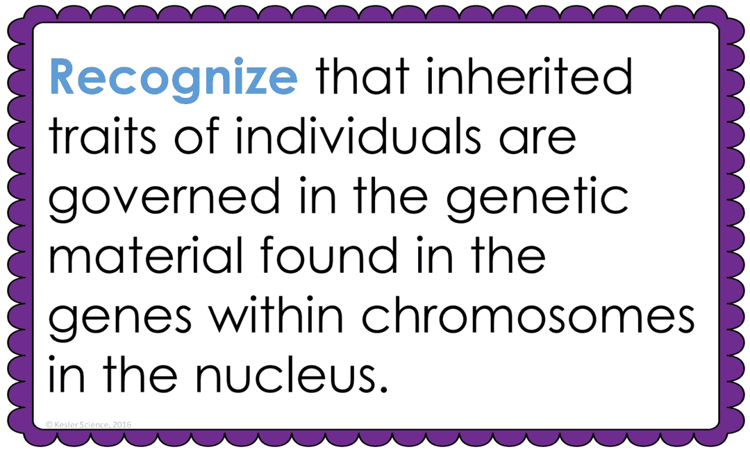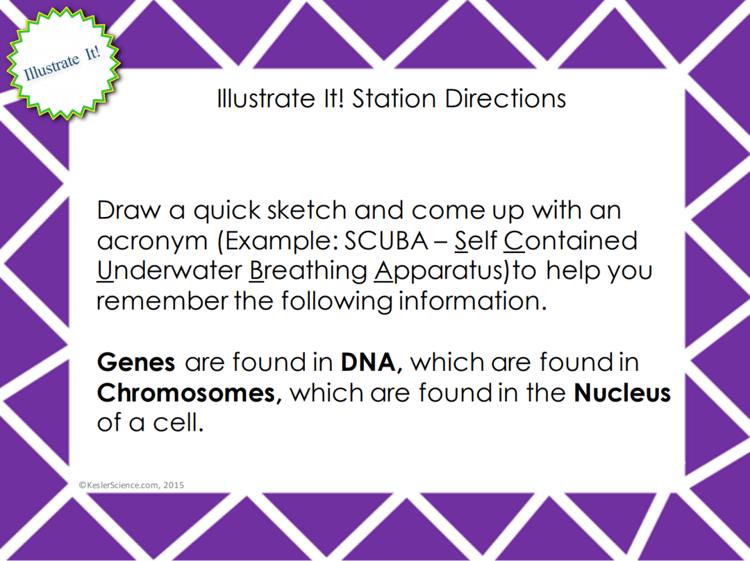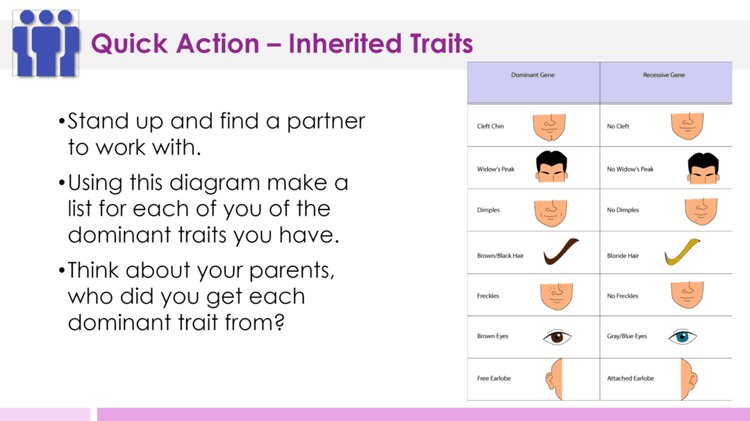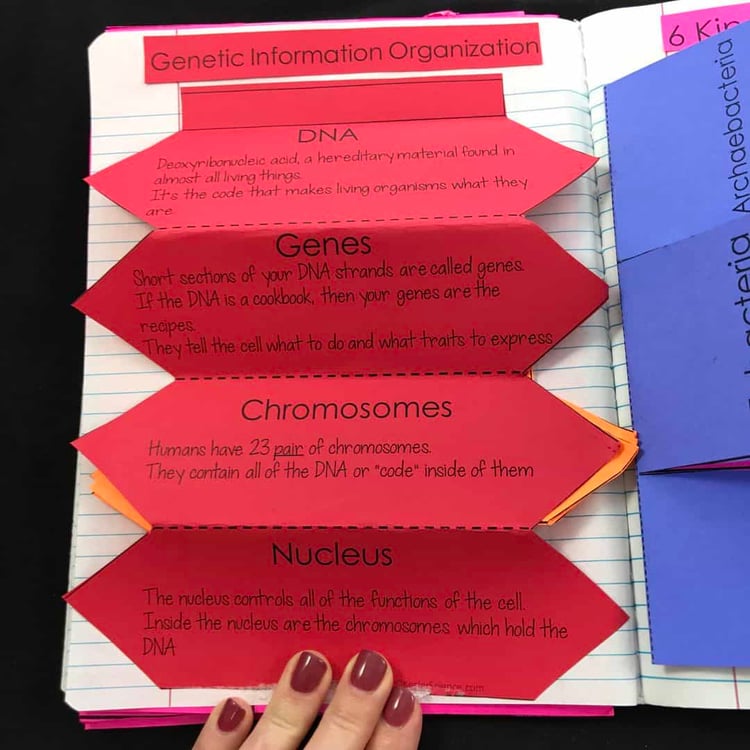INHERITED TRAITS LESSON PLAN – A COMPLETE SCIENCE LESSON USING THE 5E METHOD OF INSTRUCTION
At the end of this inherited traits lesson plan, students will be able to recognize that inherited traits of individuals are governed in the genetic material found in the genes within chromosomes in the nucleus. Each lesson is designed using the 5E method of instruction to ensure maximum comprehension by the students.
The following post will walk you through each of the steps and activities from the inherited traits lesson plan.
ENGAGEMENT
Objective Introduction
At the beginning of the lesson, the class will do a Think-Pair-Share to discuss the objective.
Class Activity
- Tell students that today they will be learning about inherited traits and where they come from.
- Watch the video listed in the 5E lesson. (Teacher may want to pause the video to give students time to take notes)
Student Activity
- Ask students to make a list of all the traits that they have seen in the video.
- Have them list the most common traits (higher %).
- After watching the video put the students in groups of 4.
- Have each group go through the traits they listed and determine if their own traits are most common or less common.
- Have the groups brainstorm other traits they think they have.
- Put the words inherited and acquired on the board.
- Have each group choose one trait to put under inherited or acquired.
- When every group has put a trait on the board, discuss the words to make sure they have an understanding of each definition.
- Ask students if they want to make any changes.

The teacher will help to clear any misconceptions about inherited traits. When people hear the word “dominant”, often they incorrectly believe the majority of the population expresses this trait. Describing a trait as dominant does not mean it is the most common; it means that it is expressed over the recessive trait.
Estimated Class Time for the Engagement: 20-30 minutes
EXPLORATION
This student-centered station lab is set up so students can begin to explore inherited traits. Four of the stations are considered input stations where students are learning new information about inherited traits and four of the stations are output stations where students will be demonstrating their mastery of the input stations. Each of the stations is differentiated to challenge students using a different learning style. You can read more about how I set up the station labs here.
EXPLORE IT!
Students will be working in pairs to better understand genetics. Students will place cards in order from smallest to largest (gene to the nucleus). Have students try to place in order without definitions before giving the set of cards with the definitions. Students will follow the steps and record their observations on their lab sheet.
WATCH IT!
At this station, students will be watching a short video explaining the passing of traits. Students will then answer questions related to the video and record their answers on their lab station sheet. For example: Why do siblings look and behave differently from each other? What are genes and where can they be found? Why are there more short-haired dogs than there are long-haired dogs?
RESEARCH IT!
The research station will allow students to explore a web page that allows the students the ability to research more about dominant and recessive traits and determine how many they have in each category. Students will be instructed to complete a few tasks and record answers on their lab sheets.
READ IT!
This station will provide students with a one page reading about inherited traits. Students will learn how traits are passed down and how the combination of inheritance and environment affect what a person might look like. There are 4 follow-up questions that the students will answer to show reading comprehension of the subject.
ASSESS IT!
The assess it station is where students will go to prove mastery over the concepts they learned in the lab. The questions are set up in a standardized format with multiple choice answers. Some questions include: Where is DNA stored in a cell? List the correct order from smallest to largest. How many chromosomes do humans have in each cell? How are genes different from DNA?

WRITE IT!
Students who can answer open-ended questions about the lab truly understand the concepts that are being taught. At this station, the students will be answering three task cards: Explain what the purpose of a gene is. How is DNA different from a chromosome? What is the difference between a dominant and recessive trait?
ILLUSTRATE IT!
Your visual students will love this station. Students are given the opportunity to draw a quick sketch of the order of gene to nucleus and to create an acronym that will help them remember the order it belongs to.

ORGANIZE IT!
The organize it station allows your students to lock in the terms used in this lesson with the correct definitions. Once students have completed their organization, the teacher will come and check their understanding.
Estimated Class Time for the Exploration: 1-2, 45 minute class periods
EXPLANATION
The explanation activities will become much more engaging for the class once they have completed the exploration station lab. During the explanation piece, the teacher will be clearing up any misconceptions about inherited traits with an interactive PowerPoint, anchor charts, and notes. The inherited traits lesson includes a PowerPoint with activities scattered throughout to keep the students engaged.

The students will also be interacting with their journals while taking notes from the PowerPoint. If you have students that need modified notes, the 5E lessons come equipped to help give every student access to the lesson.

Estimated Class Time for the Exploration: 2-3, 45 minute class periods
ELABORATION
The elaboration section of the 5E method of instruction is intended to give students choice on how they can prove mastery of the concept. When students are given choice the ‘buy-in’ is much greater than when the teacher tells them the project they will have to create. The elaboration project will allow students to create a number of different project ideas ranging from bulletin boards to a video demonstrating their understanding of inherited traits.
Estimated Class Time for the Elaboration: 2-3, 45 minute class periods (can also be used as an at-home project)
EVALUATION
The final piece of the 5E model is to evaluate student comprehension. Included in every 5E lesson is a homework assignment, assessment, and modified assessment. Research has shown that homework needs to be meaningful and applicable to real-world activities in order to be effective. When possible, I like to give open-ended assessments to truly gauge the student’s comprehension.
Estimated Class Time for the Elaboration: 1, 45 minute class period
DOWNLOAD THE FULL LESSON NOW
The full lesson is available for download from the Kesler Science Store. Save yourself a ton of time and grab it now.
Download Over $100 in FREE Resources
For Middle School Science
Simply create a login below and gain immediate access to a selection of our Kesler Science product line worth $100 - for FREE. There's a full version of every product type! You'll also join tens of thousands of middle school science teachers who receive timely tips and strategies straight to their inbox.






